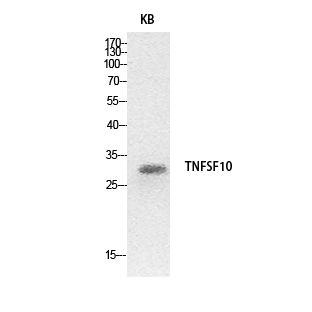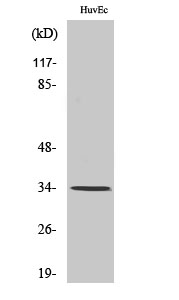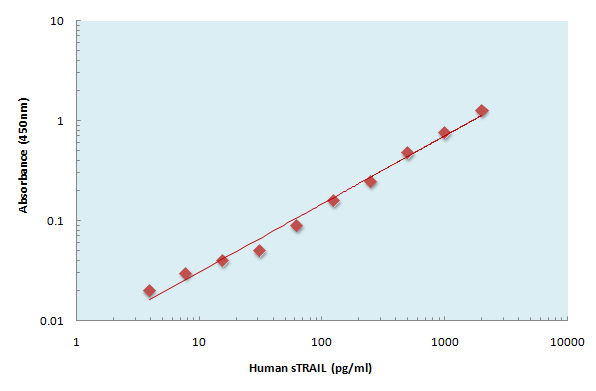
Catalog: YT5511
Size
Price
Status
Qty.
200μL
$450.00
In stock
0
100μL
$280.00
In stock
0
40μL
$150.00
In stock
0
Add to cart


Collected


Collect
Main Information
Target
TRAIL
Host Species
Rabbit
Reactivity
Human, Mouse
Applications
WB, IHC, IF, ELISA
MW
33kD (Observed)
Conjugate/Modification
Unmodified
Detailed Information
Recommended Dilution Ratio
WB 1:500-1:2000; IHC: 1:100-1:300; ELISA 1:20000; IF 1:50-200
Formulation
Liquid in PBS containing 50% glycerol, 0.5% BSA and 0.02% sodium azide.
Specificity
TRAIL Polyclonal Antibody detects endogenous levels of TRAIL protein.
Purification
The antibody was affinity-purified from rabbit antiserum by affinity-chromatography using epitope-specific immunogen.
Storage
-15°C to -25°C/1 year(Do not lower than -25°C)
Concentration
1 mg/ml
MW(Observed)
33kD
Modification
Unmodified
Clonality
Polyclonal
Isotype
IgG
Related Products
Antigen&Target Information
Immunogen:
The antiserum was produced against synthesized peptide derived from the Internal region of human TNFSF10. AA range:31-80
show all
Specificity:
TRAIL Polyclonal Antibody detects endogenous levels of TRAIL protein.
show all
Gene Name:
TNFSF10
show all
Protein Name:
Tumor necrosis factor ligand superfamily member 10
show all
Other Name:
TNFSF10 ;
APO2L ;
TRAIL ;
Tumor necrosis factor ligand superfamily member 10 ;
Apo-2 ligand ;
Apo-2L ;
TNF-related apoptosis-inducing ligand ;
Protein TRAIL ;
CD253
APO2L ;
TRAIL ;
Tumor necrosis factor ligand superfamily member 10 ;
Apo-2 ligand ;
Apo-2L ;
TNF-related apoptosis-inducing ligand ;
Protein TRAIL ;
CD253
show all
Background:
The protein encoded by this gene is a cytokine that belongs to the tumor necrosis factor (TNF) ligand family. This protein preferentially induces apoptosis in transformed and tumor cells, but does not appear to kill normal cells although it is expressed at a significant level in most normal tissues. This protein binds to several members of TNF receptor superfamily including TNFRSF10A/TRAILR1, TNFRSF10B/TRAILR2, TNFRSF10C/TRAILR3, TNFRSF10D/TRAILR4, and possibly also to TNFRSF11B/OPG. The activity of this protein may be modulated by binding to the decoy receptors TNFRSF10C/TRAILR3, TNFRSF10D/TRAILR4, and TNFRSF11B/OPG that cannot induce apoptosis. The binding of this protein to its receptors has been shown to trigger the activation of MAPK8/JNK, caspase 8, and caspase 3. Alternatively spliced transcript variants encoding different isoforms have been found for this gene. [provi
show all
Function:
cofactor:Binds 1 zinc ion per trimer.,Function:Cytokine that binds to TNFRSF10A/TRAILR1, TNFRSF10B/TRAILR2, TNFRSF10C/TRAILR3, TNFRSF10D/TRAILR4 and possibly also to TNFRSF11B/OPG. Induces apoptosis. Its activity may be modulated by binding to the decoy receptors TNFRSF10C/TRAILR3, TNFRSF10D/TRAILR4 and TNFRSF11B/OPG that cannot induce apoptosis.,similarity:Belongs to the tumor necrosis factor family.,subunit:Homotrimer.,tissue specificity:Widespread; most predominant in spleen, lung and prostate.,
show all
Cellular Localization:
Cell membrane ; Single-pass type II membrane protein . Secreted . Exists both as membrane-bound and soluble form. .
show all
Tissue Expression:
Widespread; most predominant in spleen, lung and prostate.
show all
Research Areas:
>>Cytokine-cytokine receptor interaction ;
>>Viral protein interaction with cytokine and cytokine receptor ;
>>FoxO signaling pathway ;
>>Apoptosis ;
>>Necroptosis ;
>>Natural killer cell mediated cytotoxicity ;
>>Pathogenic Escherichia coli infection ;
>>Salmonella infection ;
>>Influenza A ;
>>Lipid and atherosclerosis
>>Viral protein interaction with cytokine and cytokine receptor ;
>>FoxO signaling pathway ;
>>Apoptosis ;
>>Necroptosis ;
>>Natural killer cell mediated cytotoxicity ;
>>Pathogenic Escherichia coli infection ;
>>Salmonella infection ;
>>Influenza A ;
>>Lipid and atherosclerosis
show all
Signaling Pathway
Cellular Processes >> Cell growth and death >> Apoptosis
Cellular Processes >> Cell growth and death >> Necroptosis
Organismal Systems >> Immune system >> Natural killer cell mediated cytotoxicity
Environmental Information Processing >> Signal transduction >> FoxO signaling pathway
Environmental Information Processing >> Signaling molecules and interaction >> Cytokine-cytokine receptor interaction
Environmental Information Processing >> Signaling molecules and interaction >> Viral protein interaction with cytokine and cytokine receptor
Reference Citation({{totalcount}})
Catalog: YT5511
Size
Price
Status
Qty.
200μL
$450.00
In stock
0
100μL
$280.00
In stock
0
40μL
$150.00
In stock
0
Add to cart


Collected


Collect
Recently Viewed Products
Clear allPRODUCTS
CUSTOMIZED
ABOUT US
Toggle night Mode
{{pinfoXq.title || ''}}
Catalog: {{pinfoXq.catalog || ''}}
Filter:
All
{{item.name}}
{{pinfo.title}}
-{{pinfo.catalog}}
Main Information
Target
{{pinfo.target}}
Reactivity
{{pinfo.react}}
Applications
{{pinfo.applicat}}
Conjugate/Modification
{{pinfo.coupling}}/{{pinfo.modific}}
MW (kDa)
{{pinfo.mwcalc}}
Host Species
{{pinfo.hostspec}}
Isotype
{{pinfo.isotype}}
Product {{index}}/{{pcount}}
Prev
Next
{{pvTitle}}
Scroll wheel zooms the picture
{{pvDescr}}




















